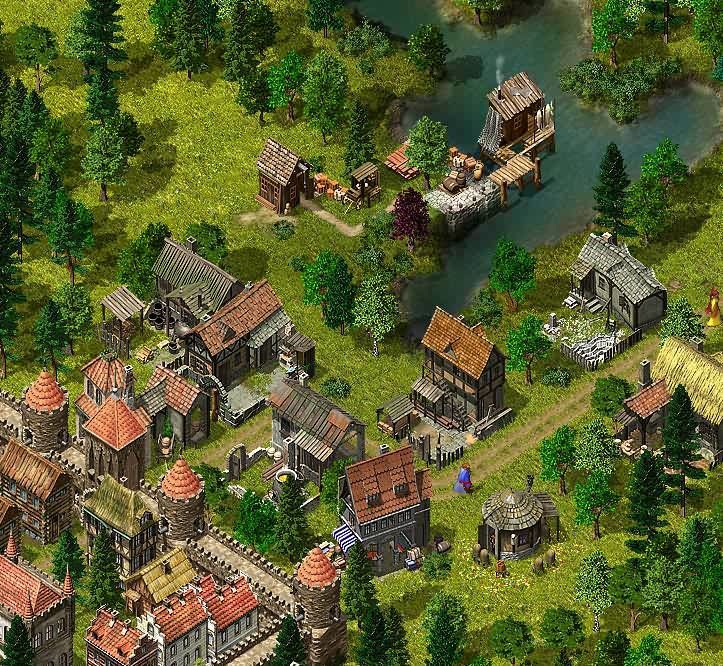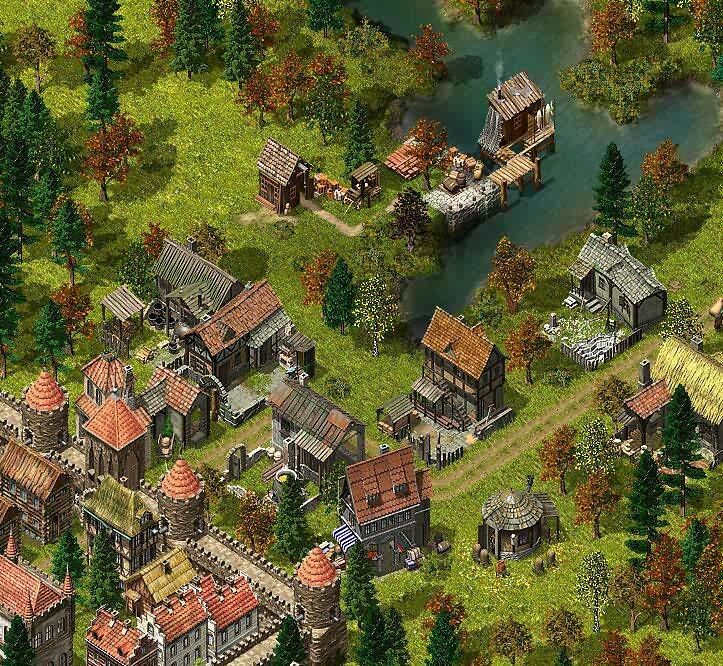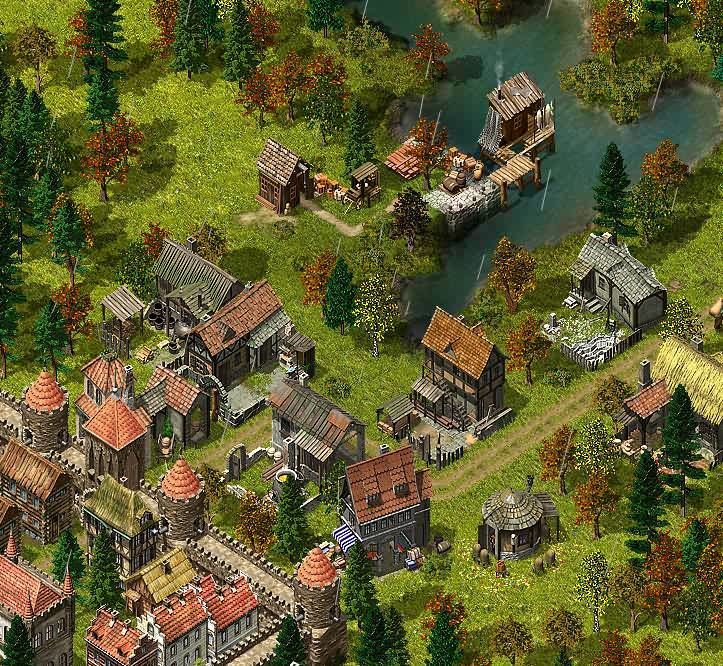For those of us who haven’t played its predecessor, Patrician III is a game where you take on the role of one of the late middle age’s trade Patricians. Your goal is to build a strong trade empire and dominate the Hanseatic League (or the Hansa) which is a trade union consisting of the many free Baltic cities. Your final goal is to be elected the leader (Alderman) of the league, handle its foreign relations and directing its defence against marauding pirate fleets or jealous renaissance princes. Reaching this position involves gradually manoeuvring from the position of a simple trader to a rich patrician. Procuring a large merchant fleet, setting up trade routes and acquiring more and more responsibility along the way. Of course, the acquiring of wealth can be achieved in more than one way, if you wish it’s possible to prey on other people’s wealth and build up a mighty pirate fleet rather than a trade empire. This path is not very likely to earn you the respect of the hanseatic cities however.
Firstly, in Patrician III there are two game types. You can play a campaign, like for instance ”The rise of the Hanseatic league”, or you can play a standard game where you define the parameters yourself. Adjustable parameters include your name, your gender, the difficulty level (this can also be customized in detail), your home town (one of twelve major Hanseatic towns around the Baltic), objective conditions (reaching a certain title, amount of wealth or population number), which map to play on (only the Baltic is included but there is support for fan made maps) and last of all the game speed (but this can be adjusted as much as you want during the game). Depending a little on your choices you’ll then start with a trading office in a Baltic city, a ship and some money to get you started.
Patrician III is a trade simulation game, you turn a profit by supplying cities that demand certain commodities. A wide range of commodities are available and the demand for them in each city is determined by that city’s population amount. Population is divided into three groups: poor, well off and rich people. Depending on the amount of the respective groups different goods come to be in demand. For instance rich people is going to demand luxury products like wine while poor people will demand goods like beer or grain. Of course as you buy a product the city’s supply will decrease, and thus the price at which you buy the goods will increase. Therefore it might be wise not to buy the entire stock of a certain good in a city even if you can afford it. Seasonal changes and special circumstances like the plague, a siege or a famine also affect the demand in certain cities greatly. At the various houses in port you are given a lot of different choices in Patrician. You’ll likely end up using or at least trying most of them (joining the traders guild can be very profitable for instance as it allows you to know where convoys are headed and what parts of the mediterrenean that has been discovered).
Once you start to gain more money you will be able to build more ships, which you can then equip as you like and hire a crew for. The game also allows you to recruit captains at the various taverns around the Baltic. This is very useful as you can order these captains to steer your ships along trade routes you define (this is done well, you define a trade route and give the captain orders about what to buy or sell and at what maximum or minumum price), thus saving you the hassle of controlling your entire merchant fleet at all times. Captains also gain experience and affect a number of things like for instance how the ship fares in sea battles or the prices at which you buy goods with that ship. If you get rich enough, you’re even able to create expeditions to go search for new markets in the Mediterranean Sea.
Should your ships be attacked by pirates, or if you chose to attack your competitors ships you will be taken to the sea battle screen. Here you are given control of your ships allowing you to defend yourself against or attack enemy ships. Sea battles typically take about 10 minutes to resolve and while not the main point of the game they work very well. Things like wind gauge and the amount of goods loaded unto your ships effect the speed at which they manoeuvre. The outcome depends a lot on how well equipped and manned your ships are. The controlls are easy to learn and ship battles are generally rather enjoyable. In port there’s a plethora of different weapons to arm your ships and crews with. Hiring large crews is a good way to ensure that you won’t get boarded by pirates, however these large crews comes with a large price tag.
Another way of earning money in Patrician is to take the various missions that will be offered to you at the city hall or in the taverns of the cities you visit. You can be offered everything from smuggling goods or hiding stolen merchandise in your warehouses, to hunting down pirates, defending the city harbour or supplying starving cities with food. These missions are usually limited by time and might also affect your reputation (for instance people will come to disregard you if you smuggle goods for someone, especially if you’re caught).
By keeping cities supplied with the goods that they need and by building workshops and housing in cities where you have trade offices you encourage them to grow and at the same time you increase your reputation. This in turn will make them demand and produce more goods. As you get more popular among the townsfolk (and arranging a few festivals with lots of free beer and food, along with a nice donation towards the extension of the church will go a long way towards assuring this) you may join the city council. This in turn will allow you to influence the decisions in the city and will even make it possible to become the new Lord Mayor.
As mayor you get the added responsibility of managing your city’s defences, which if you do it well will give you the possibility to rise even higher in the Hansa hierarchy. Even closer to your ultimate goal, to become the Alderman and leader of the entire organization.
When a city is under seige you’ll be able to see the enemy soldiers approaching your city with seige weapons fighting the guards and most likely looting the houses outside the city walls. Building outside the city walls is cheaper but doing so means there’s a greater risk of destruction when the city comes under attack.
The interface of Patrician III is quite well thought out, and while it takes a little while to get used to, it works very well to allow you to control the game effectively. Everything from the sea battles to the buying and selling of goods works very well and is smoothly integrated. It feels as if a lot of thought has gone into the planning of the interface, and this has paid off.
The game is not hard to learn, however a more thorough printed manual (even though there is a good and quite long manual for the game on the CD in PDF format) as well as more in depth tutorials would not have hurt. As it is it takes a while before one get the hang of things, especially as one has to figure out what’s a good price and what’s not (though generally looking at how much a city has in supply of certain goods will tell you if they are selling them cheap or not).
The graphics are as can be seen in the screenshots very good over all. Everything from the landscape of the bustling cities or the animations of the various buildings you can enter, to the overall Baltic map and to the battle scenes at sea are very nicely depicted. Along with the music one can hear while in port and the many ambient sounds this works well to create the appropriate atmosphere of a medieval trade game.
PATRICIAN III VERDICT
Overall this is a very well thought out and well put together game. Ascaron has created a detailed medieval trade simulation game yet managed to avoid making it too complicated to be enjoyable. The inclusion of a map editor and support for multiplayer with up to 8 players also ensures longevity. This game is in my opinion definitely worth buying.








